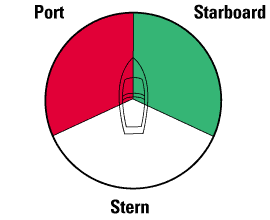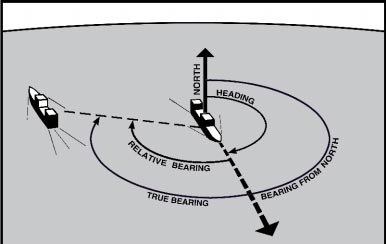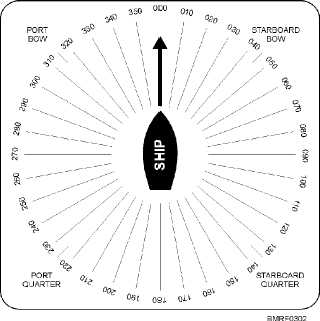Training Information for the new recruit: Basic Nautical Navigation
Basic navigation terms:
Here's a description of basic nautical terms:Degrees - a degree is 1/360 of a full circle.
- 90 degrees is a right angle turn to the right
- 270 degrees is a turn to the left
Heading - the current direction of the ship, expressed in compass degrees. Bearing -the number of degrees left or right another object is from the current heading of the ship
Starboard - The right hand side of a ship Port - The left hand side of a ship
Green - Signal lamp or direction colour associated with Starboard (right) Red - Signal lamp or direction colour associated with Port (left)
Knot - A measurement of speed, a nautical mile per hour (1.85 km/hr)
1. Port refers to the left side of the ship. The Port side always shows a Red navigation light.
2. Starboard refers to the right side of the ship. The Starboard side always shows a Green navigation light.
3. A ship's heading or bearing, and other ships locations, can be expressed as a "True Bearing" or a "Relative Bearing"
"True bearings" use" True North" (the geographic North Pole) as the reference point. A ship's direction of travel or "bearing" is expressed as the number of degrees away from True North. As an example:
A ship headed directly north has a bearing of 0 degrees. A ship headed due east has a bearing of 90 degrees.
A ship with a bearing of 180 degrees is headed due south.
A ship's "Relative bearings" use the ship's bow as a reference point. The direction of the ships travel ( looking straight ahead over the bow) is defined as 0 degrees. All other objects are located relative to this line. A ship on the Starboard beam ( to the right of the ship, at right angle to it) has a relative bearing of 90 degrees.
A ship on the Port Beam ( to the left of the ship, at right angles to it) has a relative bearing of 270 degrees.
There are two ways to express a change in a ship's heading ( its direction of travel).
The captain can call for a change in the ship's True Bearing. For example, if the ship has a current True Bearing of 45 degrees ( that's North East on a compass ) and the captain wants a turn to the Starboard (right), he might ask for a new True Bearing of 135 degrees. ( 45 degrees plus 90 degrees) - that's South-East on a compass.
The captain can also use the ship's Relative Bearing to call for a change in direction. He can call for a turn in degrees relative to the current heading of the ship. For example, an order to turn to Port (left) might be "Port 90" - a right angle turn to the left.


